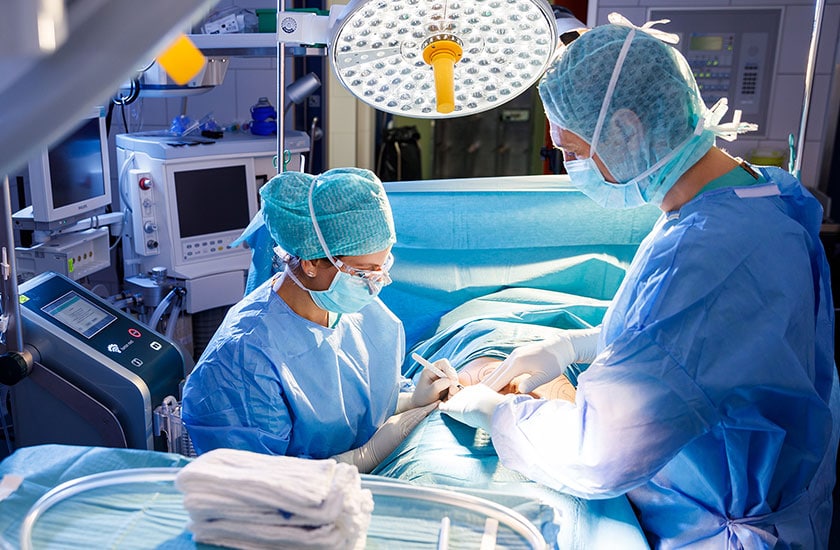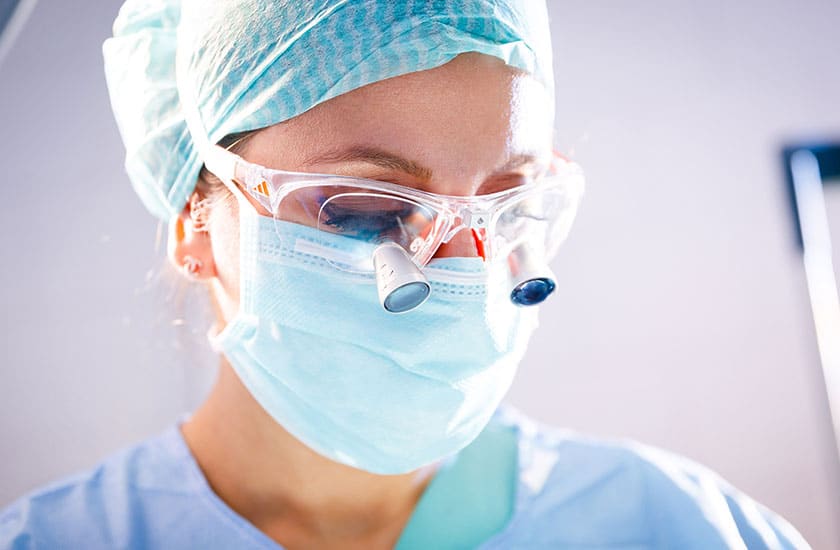Lipoedema
Our department specialises in the treatment of lipoedema and works together with vascular centres and lymphologists both within the region and beyond. Our treatments meet the standards set out in the S1 guideline, the recommendations provided by the German Society of Plastic, Reconstructive and Aesthetic Surgery (DGPRÄC) and the latest scientific publications.
Associate Professor Dr Panagiotis Theodorou has a health insurance authorisation and treats patients whose costs are fully covered by statutory health insurance as well as those who are paying for their own treatment.
Lipoedema treatment is not a cosmetic procedure; instead it is classed as reconstructive surgery with a focus on alleviating the symptoms. Despite this, the aesthetic aspect should not be ignored.
Lipoedema is a painful, chronic, progressive disease that almost exclusively affects women. It was first described back in 1940 by Edgar Hines and Edgar Allen (Mayo Clinic, Rochester, Minnesota USA).
According to epidemiological studies, over 10% of women are affected by the condition (over 4,000,000 women in Germany), but the real figure is likely to be even higher. Lipoedema is very rare among men and only tends to occur in conjunction with conditions that cause a hormonal imbalance.
Lipoedema is characterised by lipoma swellings, which occur symmetrically on the legs and/or arms, and by orthostatic oedema. The hands and feet are not affected (DD lymphoedema). The fat begins to build up above the ankle. The characteristic change in circumference between the lower leg and foot is also known as the “bracelet” effect. One typical symptom of lipoedema is a mismatch between the trunk of the body and the limbs. The condition may develop slowly or progress in stages.
In addition to pain, affected patients also complain of an increased susceptibility to haematomas (bruising). The pain is initially felt as tenderness and tightness, but later develops into spontaneous pain. The degree of pain can differ greatly from case to case.
Symptoms often worsen after standing for long periods, especially in warmer weather. In the advanced stages, the circumferential growth leads to orthopaedic problems, affects gait and causes misaligned joints. Chafing of the areas affected by lipoematosis can lead to skin irritations on the inner legs and/or arms. Patients often suffer from grave psychological issues, including depression, as a result of this condition. Although lipoedema has been proven to not be related to diet, affected patients often suffer from eating disorders as a result of their depression, which leads to the incorrect assumption that the lipoedema is caused by excessive calorie consumption. This attitude worsens the feeling of shame felt by the affected women, who often feel responsible for their “fat legs”.
Strong evidence of the different pathogenesis and pathophysiology for pathologies for lipoedema versus obesity show that, despite a high BMI, lipoedema patients suffer significantly less from diabetes mellitus than patients with the same BMI who suffer from alimentary obesity. Furthermore, “lipoedema fat” has been shown to be diet-resistant.
There are several conditions that cause similar symptoms to lipoedema and that can be difficult to distinguish from lipoedema, even for experienced medical experts. These include Decrum’s disease, phlebedema, Type 2 benign symmetric lipomatosis (Launois-Bensaude), primary lymphoedema and lipohypertrophy. Patients should undergo a detailed medical history and investigation and should seek the help of an expert who is familiar with this condition, so that the correct diagnosis can be made and the required treatment provided.
Lipoedema can be clearly diagnosed from a detailed medical history.
Typical indications include the timing of the symptoms appearing (lipoedema never occurs before puberty), the symmetrical distribution of the build-up of fat cells below the skin, oedemas, the level of pain and the susceptibility to bruising. The upper and lower parts of the body are clearly disproportionate, especially for slim women.
Ultrasound can be used as an imaging technique to confirm the diagnosis. The amount of liquid stored, circulation issues and emerging or advanced connective tissue fibrosis can all be revealed by an ultrasound examination.
The oedemas are typically located above the ankle joint. If the arch of the foot and the toes are affected (swelling, reduced folding of the skin, Stemmer’s sign), an additional secondary lymphoedema may also be present. In these cases, imaging procedures (lymphangiography, lymphoscintigraphy) can be used to clearly display the functional changes to the lymphatic system. The primary diagnosis for lipoedema is established by a lymphologist or vascular surgeon.
The causes of this condition have been researched but not clearly explained. Numerous studies have shown a correlation between lipoedema and the hormonal balance. As a result, this condition often experiences a “surge” during the phases of life when hormonal changes occur within the body. Adolescent girls going through puberty, pregnant women, women going through menopause and women who have undergone a gynaecological operation are all particularly affected. There have also been documented cases of this condition being linked to hormone-producing tumours or stressful situations. There is a genetic element in over half of the reported cases.
Healthy fat cells change in size when they absorb or deposit fat. If they increase heavily in size, we talk of hypertrophy. If the size of the fat cells remains constant but the number increases, there is a hyperplasia (excessive cell formation). Lipoedema occurs as a result of a combination of the hypertrophy and hyperplasia of fat cells caused by hormonal triggers and is not related to diet.
Lipoedema does not require changes to diet. The lipoma swellings on the extremities of patients do not decrease, even in the case of emaciation or following drastic weight reduction.
The smallest vessels of affected women have a high permeability, leading to protein-rich liquid moving from the vascular system into the tissue (oedema formation). The vascular walls are, however, not just more porous, they are also more fragile than normal, which often leads to patients bruising from trivial injuries.
The increased amount of tissue fluid places an excessive burden on the lymphatic system, which is responsible for removing tissue fluid. Despite this, the transport capacity of the lymphatic system remains intact during the first stage. As the condition advances, the protein-rich liquid in the tissue can lead to inflammations and hardening (perilymphovascular fibrosis). This then inhibits the lymph transport and leads to the formation of a secondary lymphoedema (lipolymphoedema).
Histological studies have shown that there is an increasing number of breaking down and rebuilding processes in the fatty tissue of affected women. At the same time, the fat cells in the lipoedema areas do not just increase in number; they are also considerably larger than normal cells. These characteristics support the thesis that there is an increased propagation of fat in lipoedema patients. The increase in fatty tissue leads to a mechanical compression of the venous and lymphatic drainage from the small veins and lymph vessels. This also leads to the aforementioned formation of oedema in the subcutaneous tissue.
According to the severity of the condition, distinctions are made between different stages based on the morphology. Initially, there are small and later larger subcutaneous nodules; in the later stages there is often an increasing induration (hardening) of the fatty tissue. In very severe cases affecting the lower extremities, it may affect the patient’s gait. Distinctions can also be made based on the areas of the body affected, and different classifications can be used.
The morphological classification distinguishes between 4 stages:
- Stage 1: Smooth and even skin surface, subcutaneous fatty tissue thick and soft with smaller nodules (“polystyrene skin”)
- Stage 2: Uneven skin surface with indentations, subcutaneous fatty tissue thick and increasingly hard with walnut-sized nodules (“mattress skin”)
- Stage 3: Uneven skin surface, clear increase in circumference with overhanging areas of tissue (“lobules”), subcutaneous fatty tissue thick and hard with larger nodules
- Stage 4: Lipoedema combined with a secondary lymphoedema
The disproportionate increase in the size of the limbs often leads to misaligned joints and joint degeneration in the later stages.
Classification by localisation:
- Type 1: Hips
- Type 2: Hips and thighs
- Type 3: Hips, thighs and lower legs
- Type 4: Arms
- Type 5: Lower legs
According to Herpertz (2004):
Lower extremities:
- Thigh type
- Lower leg type
- Full leg type
Upper extremities:
- Upper arm type
- Lower arm type
- Full arm type
There is no lipoedema-specific diet. As a high level of insulin promotes lipogenesis and the formation of oedema is promoted by a resistance to insulin, it makes sense to eat a diet that avoids spikes in blood sugar and insulin and that ensures sufficient gaps between meals (isoglycaemic diet).
There are various different approaches available to treat lipoedema.
The aims of the therapies are to improve lymphatic drainage, to soften the fibrosclerotic connective tissue, to alleviate the symptoms, to improve the quality of life for patients and to re-establish the aesthetic qualities of the affected extremities.
The aim should always be to combine conservative and surgical measures.
A conservative therapy should be chosen even in the early stages. Complex decongestive therapy has become established within this context.
Complex decongestive therapy includes the following components: manual lymphatic drainage, wearing compression tights, exercise, skincare and intermittent pneumatic compression. Depending on the symptoms, the symptoms of this condition can be alleviated by reducing the orthostatically conditioned oedema, and even the fragility of the vessels and thus the susceptibility to haematomas can be reduced.
The pathomechanism responsible for the development of this condition, namely the advanced increase in fat cells, remains unaffected by conservative therapy.
Liposuction is a surgical procedure that can eliminate the cause of lipoedema – namely the abnormal increase in fat cells within the affected areas.
Liposuction has existed for decades and is constantly being improved. At the same time, the cannulas used have become thinner and blunter and the instruments have been perfected.
Water-assisted liposuction (WAL), which we use in our clinic, is a very gentle procedure that can be used to treat lipoedema. The lymphatic system is not affected by WAL.
This procedure can be carried out under general anaesthetic or sedation. Despite the finest instruments and the techniques being perfected, experts are unanimous in their opinion that the level of experience that the physician has with this condition is the decisive factor when it comes to the success rate for this treatment.
Preparation for surgery
Prior to the operation, patients must receive compression therapy and lymph drainage for at least 3 months. The aim of this measure is to reduce the oedema prior to the operation to allow for a “dry liposuction”.
Surgical technique
The technique used for liposuction on lipoedema patients is vastly different from the surgical technique used on cosmetic surgery patients. In order to protect the lymphatic pathways, the aspiration should always be in a longitudinal direction. There should not be any “criss-cross” aspirations. In order to remove the maximum amount of fat, the aspiration must be carried out in several layers, always beginning with the deepest layer. Critical areas for possible damage to the lymph vessels, such as the inguinal lymph node and the “lymphatic bottleneck” on the inside of the knee, demand an extra level of caution and a detailed knowledge of the anatomy.
The amount of fat that can be removed per session and the demanding preparatory and follow-up treatment are cornerstones of an effective therapy.
A pure fat volume of between 5,000 and 8,000 ml is removed per session on average. Despite these extensive giga-liposuction quantities (lipoaspirate > 6000 ml), the aesthetic aspect is also important. It is important to consider the patient’s individual wishes prior to conducting the surgery.
Liposuction can be carried out and offered by any licensed physician. Understandably, patients often have little insight into which doctor is familiar with which technique and whether they have actually mastered the technique in question. The German Medical Association and the various state medical associations provide specialist medical training in “Plastic and aesthetic surgery” to guarantee extensive training in the field of liposuction. Doctors seeking to acquire this medical qualification must display extensive knowledge in liposuction in front of a test panel.
In our clinic, lipoedema patients are always treated as in-patients. The immediate post-operative care plan includes wearing compression clothing and regular manual lymphatic drainage. After their surgery, patients are mobilised under the supervision of a nurse and, once sufficient circulation has returned, mobilisation is done independently. Medication is given to prevent thrombosis until the patient can move sufficiently without assistance. Upon discharge, this continues to be taken as an outpatient until the patient once again has unrestricted mobility.
On the first day after the operation, electrolytes and haemoglobin are measured and, if there are no complications, the treatment can then be continued as an outpatient.
For reasons of patient safety, it is not advisable for patients to undergo this treatment as an outpatient, especially in the case of giga-liposuction (aspirate quantity > 6000 ml).
Liposuction on lipoedema patients involves specific characteristics and involves certain risks that should be discussed in advance. Furthermore, it is sensible to introduce suitable countermeasures to minimise the risk of certain complications.
Giga-liposuction can lead to haematoma, swellings and oedema. Dysaesthesia may occur, especially in the lower leg. This generally returns to normal after several months.
The risk of hypothermia (where the body temperature falls below 35 °C) is increased in comparison with other interventions as larger areas of the body surface are exposed. In certain circumstances, this can lead to cardiac arrhythmia, coagulopathies or electrolyte displacements. Thermal regulation in our clinic involves patient warming systems on exposed parts of the body, as well as the prewarming of intravenously administered substances.
For reasons of safety, all of our lipoedema patients are admitted to hospital for giga-liposuctions. This means that the vital signs can be regularly controlled in the early post-operative phase and the patients can be mobilised under supervision.
Research has shown that liposuction can significantly reduce oedema and pain. In addition, the progress of the condition can be stopped, and the patient’s quality of life improved over the long term. Often, the amount of conservative therapy required can be significantly reduced or even discontinued after liposuction.
Baumgartner et al. wrote about a long-term study lasting eight years, which showed a significant improvement in the quality of life of 85 patients with lipoedema following successful liposuction. The improvement to pressure pain and spontaneous pain and the reduction of oedema, including some eight years after successful liposuction, are all worth highlighting. Dadras et al. investigated 25 lipoedema patients who received a total of 72 sessions of liposuction. During their study, the doctors were able to ascertain that the pain of the patients was significantly reduced following the liposuction. In addition, the need for conservative measures after the operations was significantly less than prior to the operations.
Following the judgment of the Federal Social Court of Germany in Kassel on 24th April 2018 (Az. B 1 KR 10/17 R), insurance approval is only likely in exceptional cases. The justification given was that liposuction does not comply with the requirements of the quality rule in the case of lipoedema. According to § 13 Section 3a SGB V, it is only in cases where the deadline for the approval procedure is missed by the health insurance company that it is possible for the costs to be covered.
Our clinic














We are happy to
advise you in person

Our experts are here to help. They are happy to advise you and discuss all aspects of cosmetic surgery and anti-aging medicine with you in a no-obligation appointment.
Get in touch!
Please send us a message using our contact form. We will get back to you shortly.